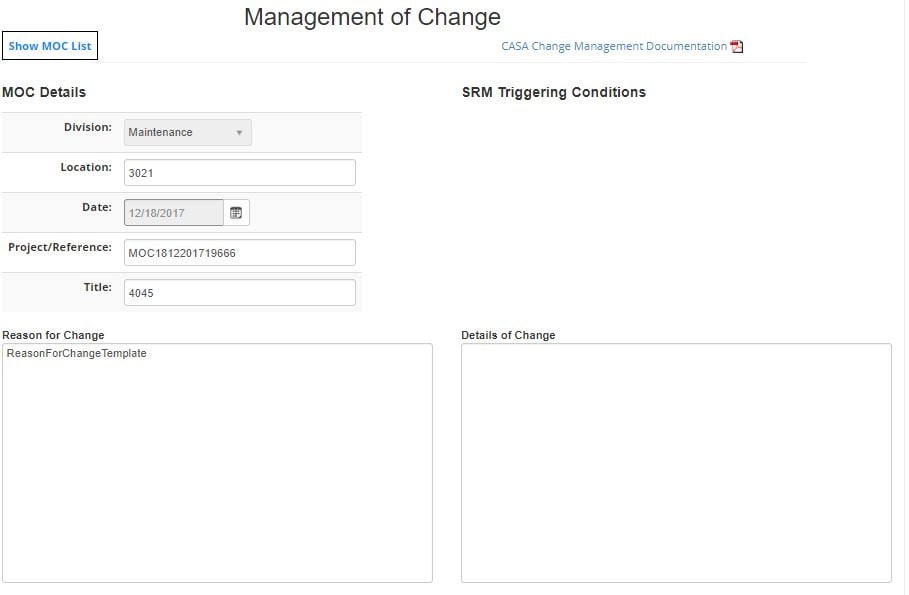What Is Management of Change in Aviation SMS

Management of change in aviation SMS is a formal process for implementing system-level changes in aviation SMS programs.
By system-level, we are talking about a change that is significant enough to affect the design of your SMS.
Small changes only affect one small part of your SMS, such as single risk control, and are implemented with corrective-preventative actions (CPAs). System changes are a higher level of change that affects multiple areas of operations.
Some common examples of change management are:
- Implementing a new route;
- Purchasing a new aircraft;
- Overhauling a particular process or significant procedure;
- Hiring a new vendor/contractor; or
- Adopting new technology, such as software or machinery.
Such examples affect multiple areas of operations, are larger in scale, and will most likely introduce new hazards and/or risks into operations. Knowing best practices for change management is extremely important for managing these risks.
Why Change Management Is Important
Having a solid change management process is a great way to ensure that changes:
- Identify all relevant hazards/risks;
- Implement the change with an Acceptable Level of Safety (ALoS);
- Successfully update the design of the safety management system to incorporate the change; and
- Predict expected SMS performance with implemented change.
Here are best practices for change management in aviation SMS.
1 - Establish Consistent Change Management Process

Your change management process is a formal process. What does this mean? A formal process is one that:
- Is documented;
- Has consistent, repeatable steps;
- Is reviewed and updated for optimization; and
- Is like a “rule” in the sense that your organization should always follow the procedure when doing a certain activity (in this case, processing change).
Your change management process should be created very early on in your SMS implementation. Your process can be simple at first and will need to be optimized as your organization grows and as you learn lessons from past change management implementations.
Your change management process should at a bare minimum include:
- Reason for change;
- Goals of this change;
- Affected parties, such as personnel, departments, environments/locations, equipment, etc.;
- Existing hazards;
- New hazards;
- Relevant risk controls; and
- Relevant safety compliance requirements.
Related Aviation SMS Management of Change Articles
- What Is Change Management in Your Aviation SMS?
- Relationship Between Management of Change, SA Process, and SRM Process
- 4 Pillars | Most Important Elements of Change Management in Aviation SMS
2 - Always Carefully Analyze Reason for Change

Knowing the reason for your change is the starting point for your change management operation. It’s extremely important to get this part right. It involves asking yourself, “What is the reason we are making this change.”
The simple answer isn’t always the best. For example, in the case of adopting a new aircraft, your answer might be, “We are making this change to implement a new aircraft.” But there likely is a deeper answer, such as
- Existing aircraft fleet is beginning to age;
- Existing aircraft is having consistent maintenance problems; or
- Existing aircraft is negatively affecting business.
In all three cases, these answers would affect the scope and goal of implementing a new aircraft. A big mistake managers make when documenting the reason for the change is to simply list the change that is occurring. This is NOT the reason for the change. The reason for the change is:
- What inspired the change; and
- What needs exist in your SMS that can be fixed with change?
Successfully documenting the correct reason for your change will lead to better analysis and better goal setting.
3 - Involve as Many Relevant Employees as Possible
Involving employees in the change management process is very important. It will ensure:
- Reduced resistance to change;
- Good delegation; and
- Good communication.
How do you involve employees in change management?
- Breaking up change into many small changes gives many opportunities for employees to help implement change (via CPAs);
- Taking surveys before change is implemented; and
- Regularly updating employees on progress.
It’s important that employees feel a part of the change rather than simply something that is happening to them.
4 - Regularly Communicate Progress for Change
Communication during the management of change process is extremely important. It helps employees feel involved in the change and offers a reason for employees to speak up about a particular aspect of change.
Regular communication means:
- Informing employees of impending change;
- Telling employees to plan for implementing change, including how employees can help;
- Offering a forum for employees to ask questions or express concerns;
- As each piece of the change is implemented, inform employees;
- Be candid about successes and failures of change as it happens; and
- When change is complete, inform employees about lessons learned and how the change will be monitored.
Changes can be communicated through a message board, email, safety meetings, newsletters, and other forms of safety promotion.
5 - Delegate Change Into Many Small Changes
Delegation is absolutely of utmost importance for smoothly and efficiently processing change. As discussed, the delegation has wide-ranging repercussions in the change management process, such as:
- Making the change manageable;
- Being able to communicate the change;
- Being able to involve employees in the change; and
- Ensuring that the change is made in small increments.
Delegation means:
- Tasking various managers with specific aspects of the change;
- Dolling out corrective actions to many different employees to incorporate them in the change; and
- Separating the responsibility of the change between an approving manager and a change-processing manager.
Last updated April 2025.





